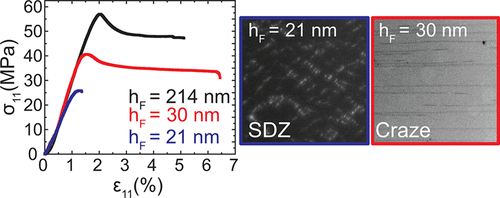当前位置:
X-MOL 学术
›
Macromolecules
›
论文详情
Our official English website, www.x-mol.net, welcomes your
feedback! (Note: you will need to create a separate account there.)
Confinement Effect on Strain Localizations in Glassy Polymer Films
Macromolecules ( IF 5.1 ) Pub Date : 2018-05-03 00:00:00 , DOI: 10.1021/acs.macromol.8b00385
R. Konane Bay 1 , Shinichiro Shimomura 1 , Yujie Liu 1 , Mark Ilton 1 , Alfred J. Crosby 1
Macromolecules ( IF 5.1 ) Pub Date : 2018-05-03 00:00:00 , DOI: 10.1021/acs.macromol.8b00385
R. Konane Bay 1 , Shinichiro Shimomura 1 , Yujie Liu 1 , Mark Ilton 1 , Alfred J. Crosby 1
Affiliation

|
The physical properties of glassy polymer films change as they become confined. These changes are often attributed to increased average molecular mobility and reduction in entanglement density. Both are known to alter mechanical behavior, including the formation of strain localizations, e.g., crazing and shear deformation zones. Here, we determine how the entanglement density and surface mobility change the mechanical behavior of a glassy polymer film when it becomes confined. We utilize a custom-built uniaxial tensile tester for ultrathin films and dark-field optical microscopy to characterize the complete stress–strain response and the associated strain localizations for ultrathin polystyrene films of varying thickness (hF = 20–360 nm). These experiments provide direct measurement of the stress in a craze as well as the stresses involved through the transition from crazing to shear deformation zones. Most significantly, we observe a transition in strain localization from crazing to shear deformation zones as film thickness changes from 30 to 20 nm, providing new insights into how the surfaces alter the mechanical behavior in confined polymer films.
中文翻译:

约束对玻璃态聚合物薄膜应变局部化的影响
玻璃状聚合物薄膜的物理性质会随着其受到限制而发生变化。这些变化通常归因于平均分子迁移率的提高和缠结密度的降低。已知两者都会改变机械性能,包括应变局部化的形成,例如开裂和剪切变形区。在这里,我们确定缠结密度和表面迁移率如何限制玻璃态聚合物薄膜的机械性能。我们利用定制的单轴拉伸测试仪来处理超薄薄膜和暗场光学显微镜,以表征完整的应力-应变响应以及不同厚度(h F= 20–360 nm)。这些实验可直接测量开裂中的应力以及从开裂到剪切变形区的过渡过程中所涉及的应力。最重要的是,随着膜厚从30纳米变化到20纳米,我们观察到应变局部从开裂到剪切变形区域的转变,从而提供了有关表面如何改变受限聚合物薄膜机械性能的新见解。
更新日期:2018-05-03
中文翻译:

约束对玻璃态聚合物薄膜应变局部化的影响
玻璃状聚合物薄膜的物理性质会随着其受到限制而发生变化。这些变化通常归因于平均分子迁移率的提高和缠结密度的降低。已知两者都会改变机械性能,包括应变局部化的形成,例如开裂和剪切变形区。在这里,我们确定缠结密度和表面迁移率如何限制玻璃态聚合物薄膜的机械性能。我们利用定制的单轴拉伸测试仪来处理超薄薄膜和暗场光学显微镜,以表征完整的应力-应变响应以及不同厚度(h F= 20–360 nm)。这些实验可直接测量开裂中的应力以及从开裂到剪切变形区的过渡过程中所涉及的应力。最重要的是,随着膜厚从30纳米变化到20纳米,我们观察到应变局部从开裂到剪切变形区域的转变,从而提供了有关表面如何改变受限聚合物薄膜机械性能的新见解。

































 京公网安备 11010802027423号
京公网安备 11010802027423号